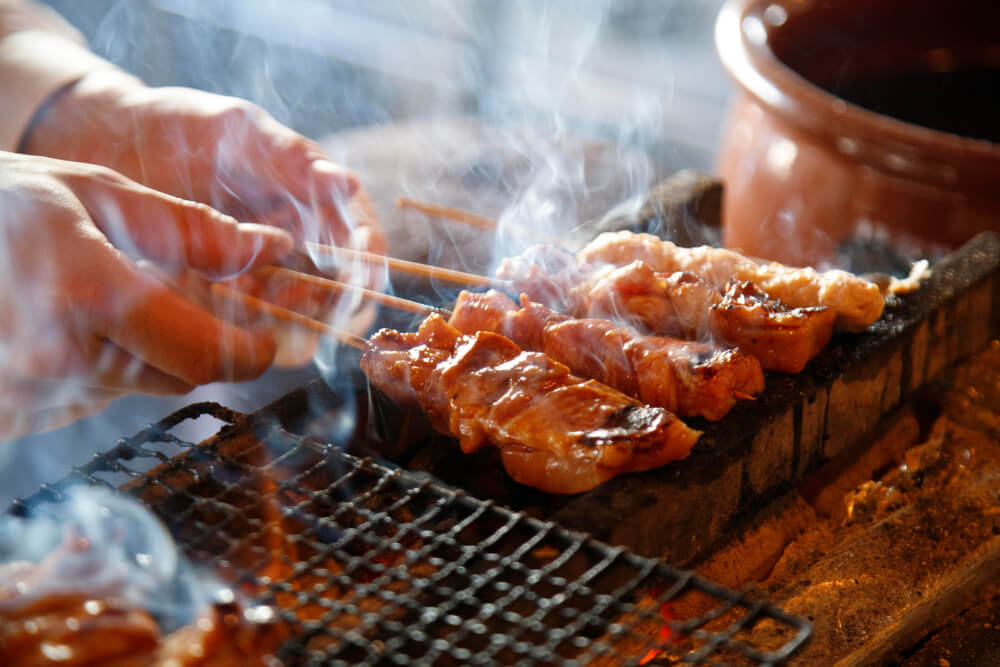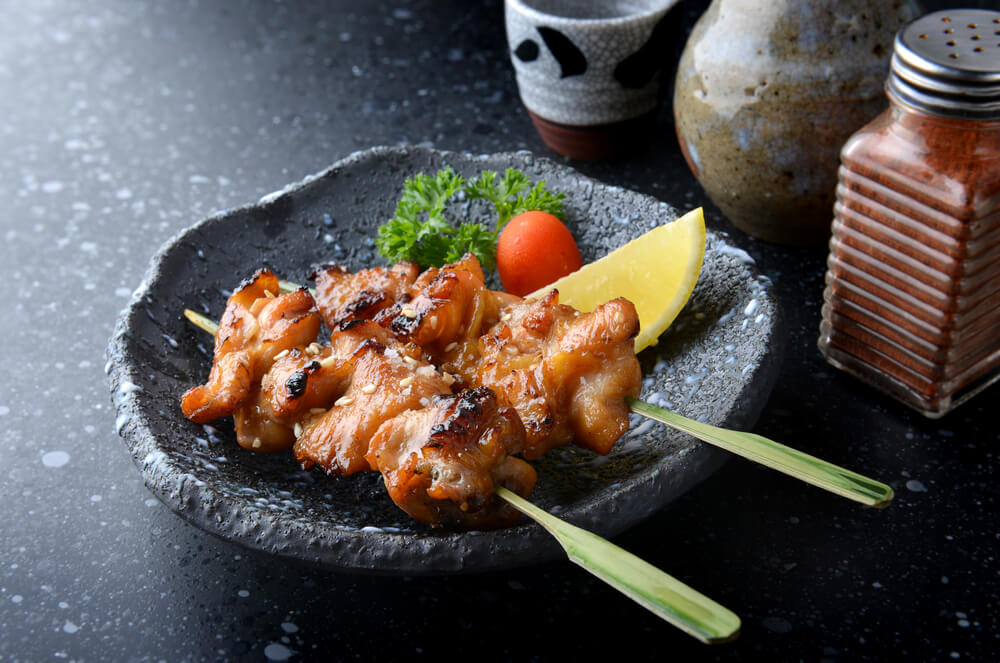Yakitori in Japanese literally translates to “grilled chicken.” The whole process of preparing this dish is rather simple and straightforward; the chef cuts the chicken into smaller pieces, places it on skewers, and then proceeds to cook it over charcoal. Thanks to this simplicity and the fact that it only takes about 5 minutes to make, yakitori has become a staple for “after-work” relaxation in Japan around the middle of the 20th century, and it still fulfills that role to a tee. It’s not uncommon to see street stalls and so-called Izakaya bars that serve yakitori together with a cold beer, with just a simple stool and table to sit on.
The beauty and appeal of yakitori lie in the fact that it’s served fresh; it’s typically made right in front of the customer after they choose what kind they’d like. And even though the dish is quick to make, the chef needs to have certain skills in order to move, turn, and season the skewers perfectly.
What Is Yakitori?
Yakitori is a delicious grilled chicken on skewers, born from the need not to waste a single part of the animal-based food, which is why they include the heart and other parts of the chicken. When eating street food, such as yakitori, try to enjoy it in a quiet place, without moving. Eating while walking is frowned upon, as you could collide with someone and ruin their clothes. So even if you don’t plan to sit by the stall or spend time at an izakaya, make sure to stick to the etiquette.

How to Prepare Yakitori
In order to make your Japanese yakitori true to its origin, you have to prepare both the tare (sauce) and the meat.
- Ingredients
For tare:
- 1 cup of chicken broth
- 1 cup of soy sauce
- ½ cup of mirin (sweet rice wine), dry white wine, or the sake
- 3/4 cup of sugar (add 2 tablespoons if you’re using sake or white wine)
- 1 trimmed scallion
- 1 clove of garlic
- 1 strip of lemon zest
For Yakitori:
- 1 ½ pound of chicken, any of the following: dark meat with or without the skin; white meat with or without pieces of fat; chicken wings with wingtips removed; chicken skin; chicken liver and/or heart; chicken embryonic eggs
- Toasted sesame seeds
The Yakitori Recipe
- Step 1: Prepare Tare First
Mix all of your tare ingredients (the chicken broth, soy sauce, mirin, sugar, white chives, garlic, ginger, and lemon zest) in a pan, cook it on medium heat, and wait for the mixture to start boiling. This is when you want to start stirring it regularly, for about 6-10 minutes until you notice the tare is nice and thick, almost like a syrup. Once this bit is done, strain the tare to another pan that you can use on the grill so that there are absolutely no solid bits inside.
- Step 2: Make Yakitori
Start by cutting the chicken into small cubes that you can easily thread on the skewers. A common practice for Japanese food yakitori is to mix different parts of the chicken; you can thread white meat, then follow it with a piece of chicken skin, then proceed with a piece of dark meat, and so on. Of course, you can stick to just one meat type if you so prefer. While it’s best to prepare yakitori fresh and grill the meat immediately after skewering it, it’s also possible to keep the prepared yakitori skewers refrigerated for a couple of hours before grilling. Just make sure to cover them with a plastic wrap.
- Step 3: Prepare the Grill
Preheat the grill on the highest setting. Once you want to start cooking, make sure to grease the grill grates; you can use a piece of chicken fat or skin for the task. Your prepared pot with tare should be waiting for you on one side of the grill. In case you’re working with a thinner grill, you can leave the bare skewer ends hanging freely, but if you’re using a larger grill, make sure to protect those with a piece of foil to avoid burning.
- Step 4: Grill the Yakitori
Grill the skewers for about 2 minutes on each side until the chicken turns white. This is when you want to dip the skewers in the tare and then resume the grilling process. Your goal should be for the chicken to turn golden brown, which typically takes 1-2 more minutes of grilling on either side. The glaze on the meat should appear shiny and the meat has to feel firm for the yakitori to be truly done. Remove it from the grill as soon as you confirm this to avoid over-roasting the meat.

- Step 5: Dip Grilled Yakitori in Tare
For the finishing touch, you should dip your roasted chicken skewers into the tare before placing them onto the plate. The ideal seasoning includes sesame seeds and green onions so sprinkle those and serve yakitori immediately. And even though it’s not a traditional practice, you can prepare some tare in a smaller bowl to use it as a dipping sauce as you eat.
Yakitori is one of the most authentic and popular Japanese comfort foods. But the tare makes all the difference. The fact that you dip the chicken twice, mid-grilling and after the roast is completed, gives the dish a rather unique and deliciously sweet and salty flavor. What’s more, some of the renowned Japanese restaurants use pots of the same tare over and over again, making the taste richer and more concentrated after each use. They simply replenish it when necessary, resulting in sauces that could be even months old, so to speak. However, this sauce is even tastier and safe to consume as it never gets in touch with raw chicken and continues to boil next to the grill.
How to Order at a Yakitori Restaurant
If you ever find yourself in Japan or a place that offers an authentic Japanese dining experience, you can expect to see an interesting yakitori parlor that looks like a bar centralized around the grill. You get a menu that features several different chicken meat parts as well as other ingredients such as vegetables, tofu, and maybe even other meats such as beef and pork belly. Then you can choose everything you want to get on your skewer portion.
Once you’re done ordering, you can expect to receive one skewer at a time. You can leave your used skewers in a provided cup. What’s more, some parlors and restaurants also offer additional condiments, such as seasoned salt, extra tare, chile spices, and so on.
If you’re interested in trying yakitori as well as other amazingly delicious Japanese comfort foods, don’t hesitate to pay us a visit at Ichimora. It’s our goal to provide our customers with carefully- and lovingly-made meals by practicing the traditional, centuries-old preparation and cooking techniques. Treat both your tummy and soul with the warmth and deliciousness of our meals while enjoying a comfortable and relaxing atmosphere at our place. We strive to create a truly amazing and mindful experience that combines a delicious bite and fulfilling personal time.


